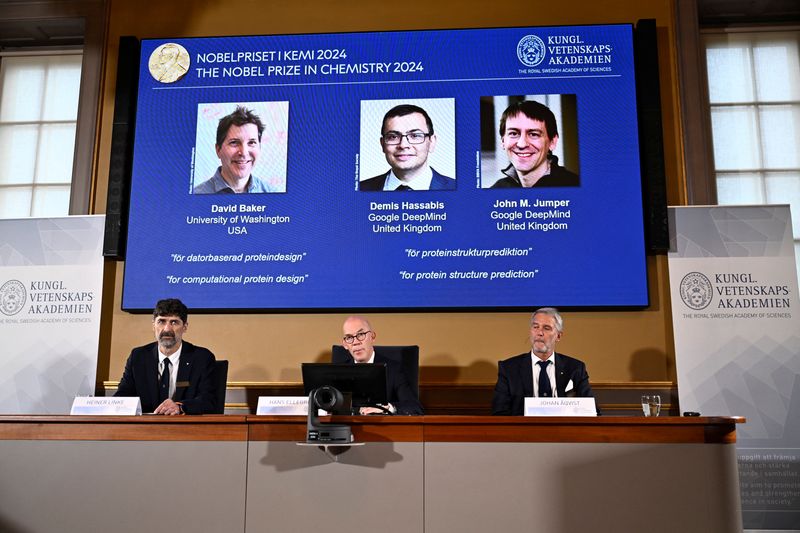By Johan Ahlander, Niklas Pollard, Marie Mannes
STOCKHOLM (Reuters) -U.S. scientists David Baker and John Jumper and Briton Demis Hassabis received the 2024 Nobel Prize in Chemistry on Wednesday for work on decoding the construction of proteins and creating new ones, yielding advances in areas akin to drug growth.
Half the prize was awarded to Baker “for computational protein design” whereas the opposite half was shared by Hassabis and Jumper “for protein structure prediction”, mentioned the Royal Swedish Academy of Sciences, which makes the award.
Baker, 62, is a professor on the College of Washington, in Seattle, whereas Hassabis, 48, is CEO of Google (NASDAQ:) DeepMind, the AI analysis subsidiary of Google, the place Jumper, 39, additionally works as senior analysis scientist.
Hassabis and Jumper utilised synthetic intelligence to foretell the construction of just about all identified proteins, whereas Baker realized tips on how to grasp life’s constructing blocks and create solely new proteins, the award-giving physique mentioned.
“It’s totally surreal to be honest, quite overwhelming,” Hassabis informed Reuters, thanking DeepMind and Google, and his colleague Jumper.
“David Baker, we’ve got to know in the last few years, and he’s done some absolutely seminal work in protein design,” he mentioned. “So it’s really, really exciting to receive the prize with both of them.”
The award is the second this week given for work involving synthetic intelligence, underscoring the rising significance of machine studying and huge language fashions for science.
“That’s always been my passion, but … it’s like any powerful general-purpose technology, it can be used for harm as well if put in the wrong hands and used for the wrong ends,” Hassabis mentioned.
The prize, broadly thought to be among the many most prestigious within the scientific world, is value 11 million Swedish crowns ($1.1 million).
‘SPECTACULAR NEW PROTEINS’
Baker mentioned he was dozing when the Royal Swedish Academy of Sciences referred to as.
“The phone rang and they started telling me about the prize and my wife started screaming very loudly,” he informed Reuters. “So it was a little chaotic at the beginning, but it was very exciting.”
Baker mentioned his work with designing new proteins was geared in direction of fixing issues, issues like world warming and new illnesses.
“If we have a lot of time to wait then new proteins might evolve to solve those problems,” he mentioned. “What we have done with protein design is to discover how to make new proteins that can solve new problems.”
In 2003, Baker was in a position to make use of amino acids, usually described as life’s constructing blocks, to design a brand new protein that was not like any present one, the academy mentioned.
That opened the door to the fast creation of various proteins for makes use of in areas akin to prescribed drugs, vaccines, nanomaterials and even tiny sensors.
“He developed computational tools that now enable scientists to design spectacular new proteins with entirely novel shapes and functions, opening endless possibilities for the greatest benefits to humankind,” Heiner Linke, chair of the Nobel Committee for Chemistry, mentioned of Baker’s contribution.
AI MODEL
In 2020, Hassabis and Jumper introduced an AI mannequin referred to as AlphaFold2. With its assist, they’ve been capable of predict the construction of nearly all of the 200 million proteins that researchers have recognized, the academy mentioned.
Among the many scientific purposes for the work, researchers can now higher perceive antibiotic resistance and create photographs of enzymes that may decompose plastic.
“We could draw a straight line from what we do to people being healthy because of what we learn about biology in the cell and everything else, and it’s just extraordinary,” Jumper, the youngest chemistry laureate for greater than 70 years, informed the Nobel web site.
The third award to be handed out yearly, the chemistry prize follows these for drugs and physics introduced earlier this week.
The Nobel prizes had been established within the will of dynamite inventor and rich businessman Alfred Nobel and are awarded to “those who, during the preceding year, shall have conferred the greatest benefit to humankind”.
First handed out in 1901, 15 years after Nobel’s loss of life, it’s awarded for achievements in drugs, physics, chemistry, literature and peace. Recipients in every class share the prize sum that has been adjusted through the years.
The economics prize is a later addition funded by the Swedish central financial institution.

Previous winners of the prize for chemistry, a self-discipline near Alfred Nobel’s coronary heart and probably the most relevant to his personal work as an inventor, have included scientific greats akin to radioactivity pioneers Ernest Rutherford and Marie Curie.
Alongside the money prize, the winners might be introduced a medal by the Swedish king on Dec. 10, adopted by a lavish banquet in Stockholm metropolis corridor. ($1 = 10.3632 Swedish crowns)




